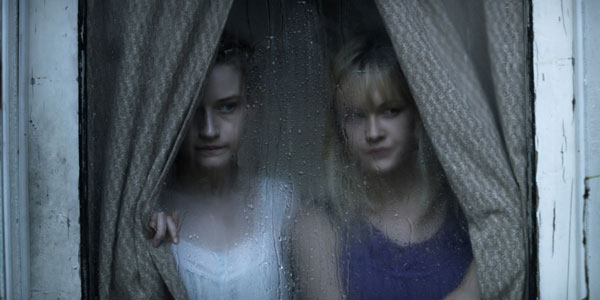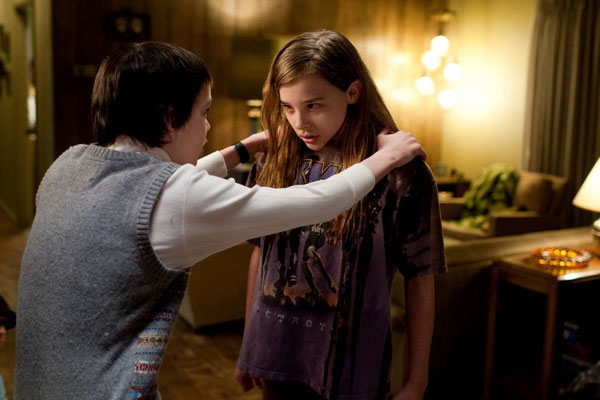
Julia Garner and Ambyr Childers star as sisters with a dark secret, in “We Are What We Are.”
Mickle’s remake a rare horror film for adults
BY SEAN EGAN | Jim Mickle’s newest feature, “We Are What We Are,” is a strange and contradictory beast. Though ostensibly a horror movie, one could mistakenly take the film for just another dark family drama — at least in its first half. While technically a remake of Mexican director Jorge Michel Grau’s 2010 film of the same name, it differentiates itself enough from its source material to become almost unrecognizable from the original. By taking an outlandish concept which practically begs to be portrayed campily, and treating it with deadly seriousness, the “remake” distinguishes itself as one of the greatest horror movies in recent memory.
Working from a skeletal outline of the original’s plot, director Mickle and co-screenwriter Nick Damici transplant the action to the Catskills, during a period of intense storms. The film concerns the Parker family, who are set adrift after their mother suddenly drops dead of a mysterious ailment.
Despite this loss, family patriarch Frank Parker (Bill Sage) insists his eldest daughter Iris (Ambyr Childers) assume his late wife’s duties, in order for the family proceeds with their traditional observance of the upcoming “Lamb’s Day” — a dark ritual that involves unspeakable acts. While the Parker clan prepares for their grisly festivities, a local doctor with a personal motive (Michael Parks) investigates clues brought out by the storm, which bring him closer to discovering the Parkers’ secrets.
While this story has the makings of a pulpy thriller, Mickle wisely treats the material seriously. The film unfolds slowly and deliberately, allowing room for the characters and their world to be established, without Mickle ever overplaying his hand and revealing too much about the secrets to come. Cinematographer Ryan Samul captures the gorgeously melancholy grays, greens and earth tones of the foggy, rain- soaked Catskills, in addition to the darkness of the Parkers’ home, which hearkens back to olden times.
Though there is gore, as well as a couple of effective scares, the emphasis of “We Are What We Are” is placed more on its moody, contemplative atmosphere. Mickle has clearly made a mature horror film for adult audiences, filled with prodding questions on the nature of man and man’s capacity for evil — and his direction makes this distinction clear.
Understandably, then, Mickle and Damici’s screenplay is not as concerned with corporeal horror as much as it is with the underlying cause of it — the domestic horrors of misguided religious fervor. This concept is embodied by Sage’s Frank Parker, a formidable presence that dominates the film. Sage plays Frank, an intimidating, mumbling, Bible-quoting patriarch in almost total control of his family, who seem to love him and fear him in equal measure. Unremorseful and even proud of the violent atrocities he’s committed and the trouble he’s put children through in the name of his ancestral faith (a relatively nebulous faith largely drawn from a pioneer-era journal and Christian Fundamentalism), he is a true figure of destruction and evil, and a damning portrait of religion gone awry.
The film might get too heavy and unpleasant to bear, were it not for the efforts of the other actors in the cast, who are across-the-board stellar. Childers’ performance makes Iris’ internal struggle both sympathetic and terrifying in equal measure. Even better is Julia Garner as the younger daughter, Rose — a fragile, pale presence whose existential quandaries and growing doubts about her faith and father place her squarely as the heart of the film. As Doc Barrow, Michael Parks is genuinely likable, and imbues his character with a quiet sadness and understated cunning. Kelly McGillis and Wyatt Russell round out the cast, as sweet and earnest individuals unfortunate enough to become entwined with the destructive lives of the Parkers.
The methodical, controlled buildup of the film gradually ratchets up the stakes, until the film reaches a quiet fever pitch. For the most part, the violence is merely uncomfortable to watch, while the Parker daughters’ interactions with their father are what truly disturb and unnerve. Indeed, there is a greater sense of unease and dread at the Parker family dinner table than there is during any scene of violence in the movie — that is, until the final sequence. This carefully executed method is largely what allows that finale to be as incredibly effective a payoff as it is.
The climax is absolutely shocking, unexpected and satisfying — one that serves the characters well, gives the audience food for thought and provides gore-hounds with an exquisitely disgusting scene of blood and guts. Balancing a nuanced character drama within the confines of a horror movie is a difficult balancing act — but it’s one “We Are What We Are” pulls off with style and smarts to spare.

Kodi Smit-McPhee and Chloe Grace-Moretz navigate hormones and horror, in “Let Me In.”
MORE MOVIES TO DEVOUR
If you enjoy “We Are What We Are,” or if this review has piqued your interest, the following films will satisfy your craving for deliciously disturbing and offbeat horror.
“We Are What We Are” (Jorge Michel Grau, 2010) Jorge Michel Grau’s original is a completely different (but complimentary) viewing experience to Mickle’s film. Employing the same essential premise, Grau forgoes religion and family drama, and instead concocts a clever social allegory set in a sprawling Mexico City — shown here to be a cinematic hellhole. Punctuated with dark humor, grimily stylized cinematography and sly nods to the work of Guillermo del Toro, the original should be required viewing for any foreign horror fan looking for a unique directorial vision.
“Red State” (Kevin Smith, 2011) Comedy director Kevin Smith tries his hand at horror. It mines the same ideas of religious zealotry “We Are What We Are” deals with in a more direct manner, to unsettling effect. It also features another wonderful turn from Michael Parks, who shines in the villainous role of a preacher with a distressing sense of conviction — and gets to deliver a chilling extended sermon that’s worth the price of admission alone. While whiplash shifts in tone don’t always serve the film well, the abundance of ideas and game supporting cast (John Goodman, Melissa Leo) keep the whole show afloat and make “Red State” highly enjoyable and well worth watching.
“Funny Games” (Michael Haneke, 2007) This might be one of the most fascinatingly nihilistic films ever put to celluloid — and certainly the only to be captured twice. Director Michael Haneke filmed a shot-for-shot English language remake of his home invasion psychological horror-thriller after his original version failed to reach his desired audience a decade earlier (namely, Americans). Chock full of ideas, “Funny Games” is as much a thesis on movie violence and the nature of the horror genre as it is a feature film, and uses gloomy, gray cinematography and long, deliberate takes to create tension and discomfort. Like “We Are What We Are,” it uses scenes of shocking violence in order to make its audience think deeply about what they’re watching.
“Let Me In” (Matt Reeves, 2010) This Americanized adaptation/remake of a foreign horror film is more faithful to the source material than “We Are What We Are.” Moody, dark and deeply bittersweet, it has just the right ratio of character work and neck-biting gore one would expect from an adolescent coming of age film/vampire movie hybrid. As in “We Are What We Are,” it’s anchored by great performances from young actors (particularly Chloe Grace Moretz), and examines the way that the horror violence presented profoundly affects its characters, their psychology and the realistically drawn world around them.
“The Silence of the Lambs” (Jonathan Demme, 1991) The deserved winner of five Oscars, the movie has aged incredibly well — thanks in no small part to Demme’s assured direction and Anthony Hopkins’ iconic portrayal of the dignified, deranged Dr. Hannibal Lecter. What’s more, “Silence” helped to bring mature, adult horror into the mainstream after a decade dominated by campy Krueger and Voorhees-driven slashers.
FILM
WE ARE WHAT WE ARE
Written by Nick Damici & Jim Mickle
Directed by Jim Mickle
Rated R
1 hour, 40 minutes
At Landmark Sunshine Cinema
143 East Houston St. (btw. First & Second Aves.)
Also at AMC Empire
234 W. 42nd St. (btw. 7th & 8th Aves.)

















